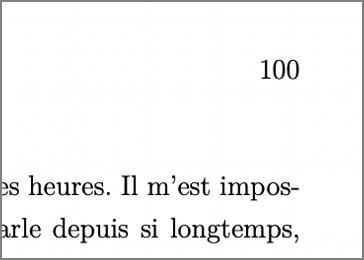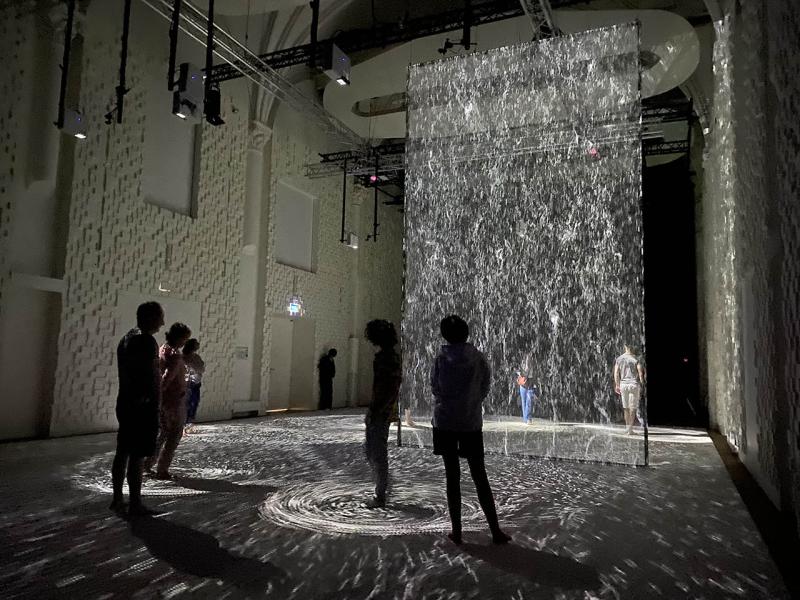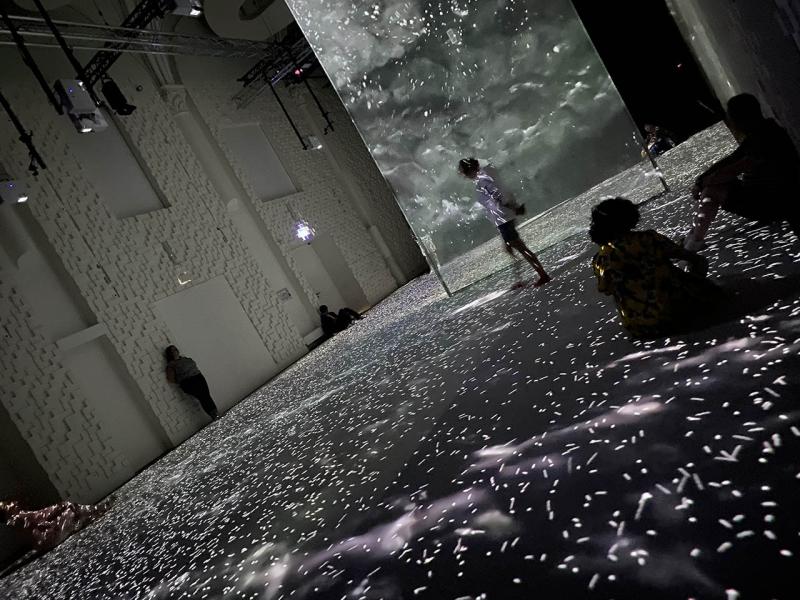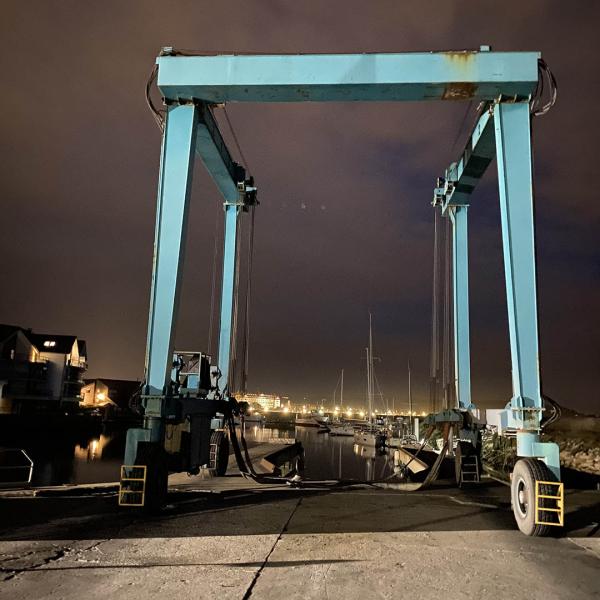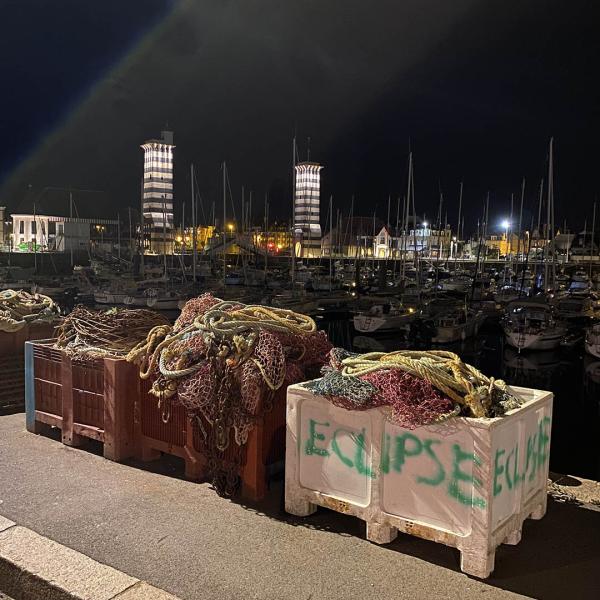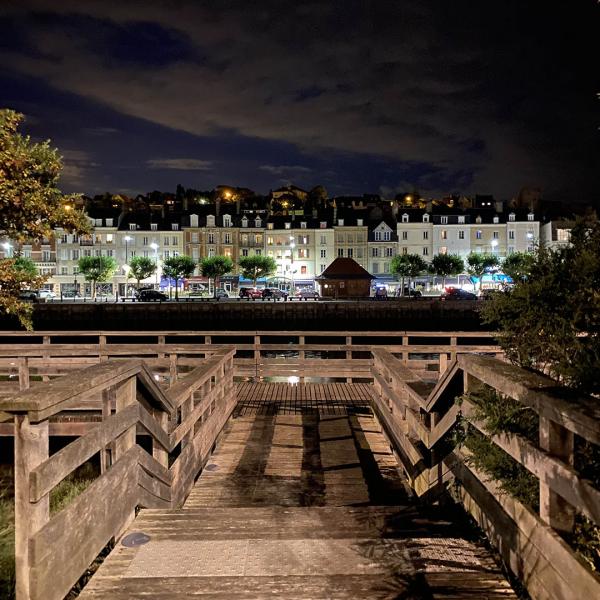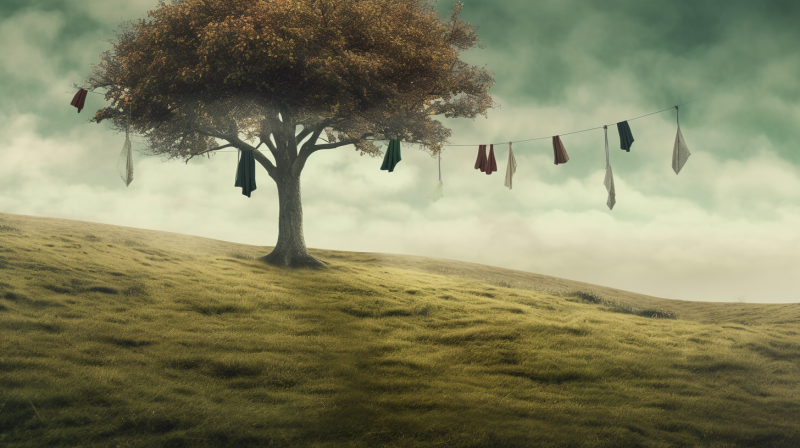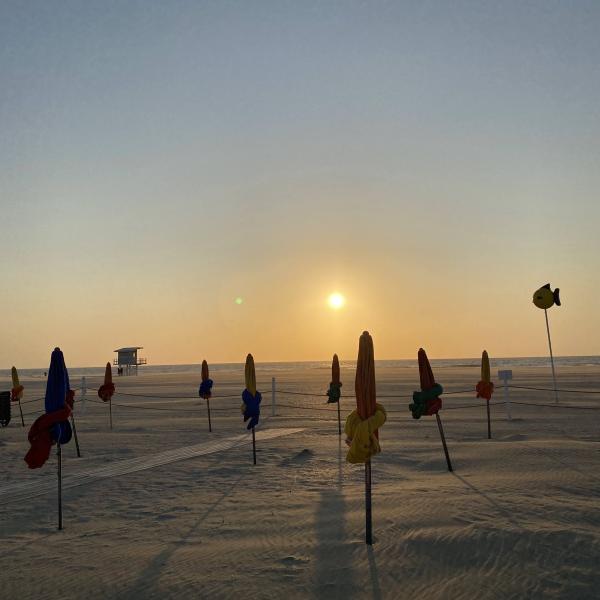This is Not Water (And Not Art)
At the Franciscaines to work. I see there's an immersive installation starting in 5 minutes. Since I have a friend in there and she has never been able to convince me it's worth it, I drop off my bag at the cloakroom and go in. We'll see.
The installation is called "Dernière Minute" (Last Minute), but it could have easily been called "Particle Generator" because that's all it is. For half an hour.
It starts with thirty seconds of voiceover where a woman talks about scattering her father's ashes in the sea - probably to make the committees and Arte believe there's some depth to it. Then, it's never mentioned again.
At first, it's nice. The first minute. (That should have been the title!) Particles on the floor and walls that resemble water or smoke. Then... it stays the same. For 29 minutes. Moving dots. Then lines. Then dots and lines. Then more water... even though the actual sea is literally a hundred meters away.
(You can imagine the dystopian future where we'll be dragging children into these kinds of installations to give them an idea of what it's like to "walk in water." I assure you, it's nothing like it.)
After ten minutes, very unpleasant flashes. Everyone closes their eyes. We look at the walls. What's the point? ("But of course! It's the pain of mourning! The rupture of... blah blah blah!")
So yes, it's beautiful to look at in photos. That's why I went. But when you're there, it's hollow. Artificial. It doesn't tell anything. It feels like they came up with every possible geometric combination to make it last half an hour. For the illustration of a concert or live performance: sure, why not. But on its own...
The usher encouraged us at the beginning to "move, interact." We quickly realized it's quite gimmicky, and towards the end, almost everyone was sitting down.
The only thing I gained from it? Ten euros.
Oh no, I lost those too.
What a load of crap.
Night Photography
I use my phone's camera to take photos of my son or - as you know - far too many beach photos. Last night, I discovered the night mode feature, which is quite impressive.
It made me think about all the things we used to have to set up in the past to achieve the same result - well, maybe not so terrible: just a tripod. But still, progress.
My First Attempt at Creating Humans
Against all expectations, creating life is easy, fast, and free:

Portrait created on Midjourney and then animated on Cutout. I spent part of the afternoon exploring artificial intelligence tools that could be useful for my films, including Runway. It's still early days, but it's happening.
Bat Filmed Upside Down = Gothic Nightclub
You film bats hanging upside down, flip the camera, and bam! Here we are on a Wednesday nigh in an 80s German nightclub:
The basic idea remains clever: filming bats upside down upside down. So, right side up. Until one of them tries to pour itself a drink.
Why It Seems Everything We Knew About the Global Economy Is No Longer True
An article on the front page of the U.S. edition of The New York Times this weekend, which would have been difficult to imagine a few years ago.
To summarize: the trust placed in the market and liberalization after the fall of the USSR - some spoke of the "End of History" - is increasingly showing its limits. Not only has globalization not brought peace, transformed dictatorships into democracies, or ended poverty, but we are living in one of the most unequal eras in history, and the forthcoming changes - energy, climate, and socio-political - are likely to exacerbate this in ways that are difficult to imagine.
So, nothing very new for those who stay informed.
The novelty is that it is on the front page of The New York Times.
Emptiness and Fabrication
Two pillars of Buddhism recently explored through the wonderful book "Seeing that Frees" by the late Rob Burbea, listening to the lectures of James Low that I discovered recently, and tirelessly through the recordings of Alan Watts, who never ceases to amaze me.
Emptiness does not mean there is nothing.
And rightfully so: we see, we hear, we feel. We think. We imagine. Regardless of the origin of these perceptions and the nature of the reality that produces them, we can agree on one thing: we do experience something. So no, there is not nothing.
However, as soon as we focus on a specific object - a tree, a chair, a passerby - we discover that it is extremely difficult to define anything independently of the rest.
The tree, for example. What makes a tree a tree?
Easy! Let's see... A trunk. Branches. Leaves. Roots... There you have it!
Question: does the soil around the roots belong to the tree? Answer: no, the soil is the soil. The tree is the tree. They are two separate things. Fair enough. However, have you ever seen a tree without soil? And if there is no tree without soil, is it reasonable to exclude one from the definition of the other? Along the same line, does the air belong to the tree? Before answering, remember that wood comes from the carbon in the air trapped through photosynthesis. ("Trees don't grow out of the earth" Feynman said, "they grow out of the air.") And, to follow the reasoning to its conclusion, since there is no tree without photosynthesis, and no photosynthesis without the sun, shouldn't the sun be included in the definition as well?
And the shape itself, the color of the leaves, the scents of wood and chlorophyll, the roughness of the trunk, do all of these have any meaning if there are no beings in the same world endowed with vision, smell, and touch to experience them? Therefore, are these characteristics inherent to the tree or inherent to those who perceive them? Is green a property of the leaves or a property of our visual cortex when we look at a leaf? And in that case, is it reasonable to exclude ourselves from the definition?
Tree (noun): Piece of the universe made of soil, air, and sun, with leaves which appear green when observed by some animals.
For Buddhists, nothing exists independently of the rest.
To think of the tree without the soil, the object without context, the part without the whole is to create concepts that mask the true nature of things. Of course, sometimes it's very practical. Our brains not being infinitely expandable, we need to simplify. When I choose my socks in the morning, I don't think every day about the cosmic connection that links each fiber of the fabric to the rest of the universe. I pick the striped ones because they smell less.
The problem arises when we forget that the concept is just a concept.
My sock, like the tree, has no inherent essence, no cardinal characteristic that can be isolated from the rest. That's what "emptiness" is: the impossibility of defining an object by itself. So when, for the sake of convenience, I consider it as a separate entity, I create a concept. And so far, so good: if it makes my life easier and helps me communicate, why not? But when I take this concept for reality, that's when the beans are spilled. I forget that the word "tree" is just an internal representation of a piece of the whole that, at all levels - physically, biologically, historically - cannot be separated from the rest. In doing so, I create an object that doesn't exist.From nothing, I have populated my reality with a new element that will transform my view of the world. That's what "fabrication" is.
The problem with fabrication? It isolates.
By constantly conceptualizing, everything seems disconnected from everything else. Objects from each other. People from each other. Self from others. The world from oneself. We forget that this separation between each thing is just an idea that we ourselves manufactured to grease the wheels of daily life. From it arises a certain solitude, competition, and a desire for control.
The goal of meditation, especially in the practice of non-duality, is to deconstruct these concepts one by one in order to perceive the world once again as it is. Whole. Unique. Present. And of which, just like trees and socks, we are an integral part.
And Chip Wickham, Do You Know Him?
Of course, you know him. Because you're cool like that, and nobody tells me anything.
I discovered him through this video about the sampler I use (SP404 mkII), posted by Ricky Tinez, whom I mentioned here. But you also know him, obviously.
The Large and the Small
Two videos watched several years apart, yet both left a similar lasting impression on me.
The first one, "Journey to the Andromeda Galaxy," made me truly grasp the vastness of the universe. As an engineer, I already knew it was immense... but not to this extent. Take a look, it's a fascinating mini-documentary that completely disrupts our perception of space and time scales.
For the infinitely small, a short video: a protein "walking" on a microtubule. As I speak to you, billions of proteins are calmly walking inside your cells.
As Pascal once said, we find ourselves lost between these two infinities. Good night.

